Top Crypto Trading Platforms in 2025




Big news: We’re cranking up the heat on AI-driven crypto analytics with the launch of the Token Metrics API and our official SDK (Software Development Kit). This isn’t just an upgrade – it's a quantum leap, giving traders, hedge funds, developers, and institutions direct access to cutting-edge market intelligence, trading signals, and predictive analytics.
Crypto markets move fast, and having real-time, AI-powered insights can be the difference between catching the next big trend or getting left behind. Until now, traders and quants have been wrestling with scattered data, delayed reporting, and a lack of truly predictive analytics. Not anymore.
The Token Metrics API delivers 32+ high-performance endpoints packed with powerful AI-driven insights right into your lap, including:
Getting started with the Token Metrics API is simple:
At Token Metrics, we believe data should be decentralized, predictive, and actionable.
The Token Metrics API & SDK bring next-gen AI-powered crypto intelligence to anyone looking to trade smarter, build better, and stay ahead of the curve. With our official SDK, developers can plug these insights into their own trading bots, dashboards, and research tools – no need to reinvent the wheel.
Crypto is transitioning into a broadly bullish regime into 2026 as liquidity improves and adoption deepens.
Regulatory clarity is reshaping the classic four-year cycle, flows can arrive earlier and persist longer as institutions gain confidence.
Access and infrastructure continue to mature with ETFs, qualified custody, and faster L2 scaling that reduce frictions for new capital.
Real‑world integrations expand the surface area for crypto utility, which supports sustained participation across market phases.
This backdrop frames our scenario work for DOGE. The bands below reflect different total market sizes and DOGE's share dynamics.
Read the TLDR first, then dive into grades, catalysts, and risks.

How to read it: Each band blends cycle analogues and market-cap share math with TA guardrails. Base assumes steady adoption and neutral or positive macro. Moon layers in a liquidity boom. Bear assumes muted flows and tighter liquidity.
TM Agent baseline: Token Metrics lead metric, TM Grade, is 22.65 (Sell), and the trading signal is bearish, indicating short-term downward momentum. Price context: $DOGE is trading around $0.193, rank #9, down about 3.1% in 24 hours and roughly 16% over 30 days. Implication: upside likely requires a broader risk-on environment and renewed retail or celebrity-driven interest.
Live details: Dogecoin Token Details → https://app.tokenmetrics.com/en/dogecoin
• Scenario driven, outcomes hinge on total crypto market cap, higher liquidity and adoption lift the bands.
• Technology: Technology Grade 54.58% (Activity 36%, Repository 72%, Collaboration 61%, Security N/A, DeFi Scanner N/A).
• TM Agent gist: cautious long‑term stance until grades and momentum improve.
• Education only, not financial advice.
8T: 
16T: 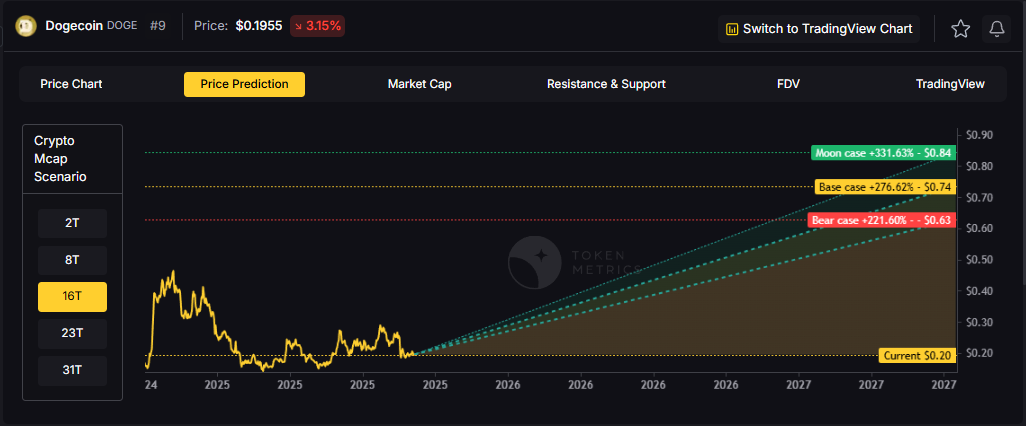
23T: 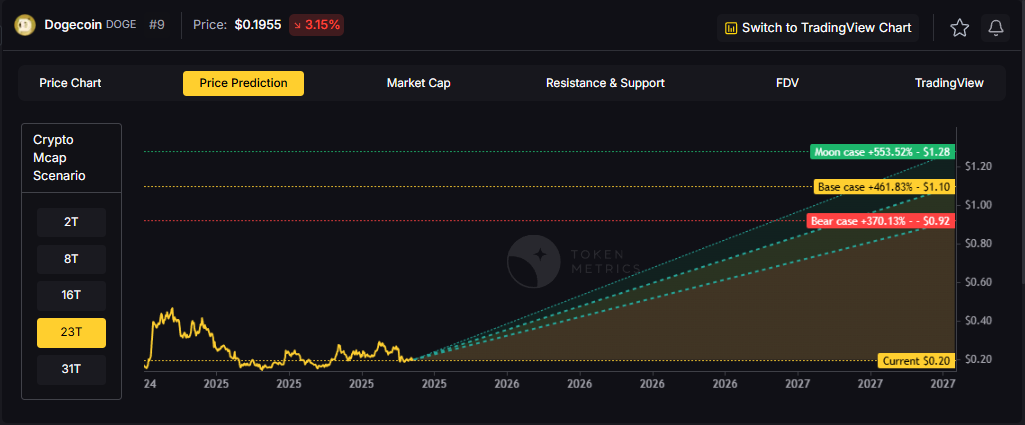
31T: 
Diversification matters. Dogecoin is compelling, yet concentrated bets can be volatile. Token Metrics Indices hold DOGE alongside the top one hundred tokens for broad exposure to leaders and emerging winners.
Our backtests indicate that owning the full market with diversified indices has historically outperformed both the total market and Bitcoin in many regimes due to diversification and rotation.
Dogecoin is a peer-to-peer cryptocurrency that began as a meme but has evolved into a widely recognized digital asset used for tipping, payments, and community-driven initiatives. It runs on its own blockchain with inflationary supply mechanics. The token’s liquidity and brand awareness create periodic speculative cycles, especially during broad risk-on phases.
Technology Snapshot from Token Metrics
Technology Grade: 54.58% (Activity 36%, Repository 72%, Collaboration 61%, Security N/A, DeFi Scanner N/A).
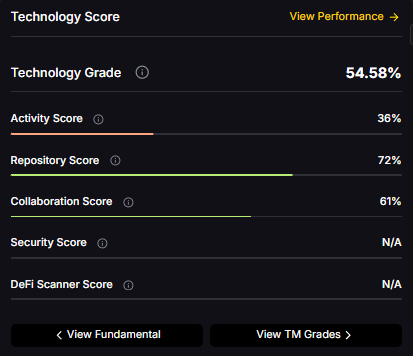
Catalysts That Skew Bullish
• Institutional and retail access expands with ETFs, listings, and integrations.
• Macro tailwinds from lower real rates and improving liquidity.
• Product or roadmap milestones such as upgrades, scaling, or partnerships.
Risks That Skew Bearish
• Macro risk-off from tightening or liquidity shocks.
• Regulatory actions or infrastructure outages.
• Concentration or validator economics and competitive displacement.
Special Offer — Token Metrics Advanced Plan with 20% Off
Unlock platform-wide intelligence on every major crypto asset. Use code ADVANCED20 at checkout for twenty percent off.
• AI powered ratings on thousands of tokens for traders and investors.
• Interactive TM AI Agent to ask any crypto question.
• Indices explorer to surface promising tokens and diversified baskets.
• Signal dashboards, backtests, and historical performance views.
• Watchlists, alerts, and portfolio tools to track what matters.
• Early feature access and enhanced research coverage.
Can DOGE reach $1.00?
Yes, multiple tiers imply levels above $1.00 by the 2027 horizon, including the 23T Base and all 31T scenarios. Not financial advice.
Is DOGE a good long-term investment?
Outcome depends on adoption, liquidity regime, competition, and supply dynamics. Diversify and size positions responsibly.

• Track live grades and signals: Token Details
• Join Indices Early Access
• Want exposure Buy DOGE on MEXC
Disclosure
Educational purposes only, not financial advice. Crypto is volatile, do your own research and manage risk.
The crypto market is shifting toward a broadly bullish regime into 2026 as liquidity improves and risk appetite normalizes.
Regulatory clarity across major regions is reshaping the classic four-year cycle, flows can arrive earlier and persist longer.
Institutional access keeps expanding through ETFs and qualified custody, while L2 scaling and real-world integrations broaden utility.
Infrastructure maturity lowers frictions for capital, which supports deeper order books and more persistent participation.
This backdrop frames our scenario work for TRX. The bands below map potential outcomes to different total crypto market sizes.
Use the table as a quick benchmark, then layer in live grades and signals for timing.
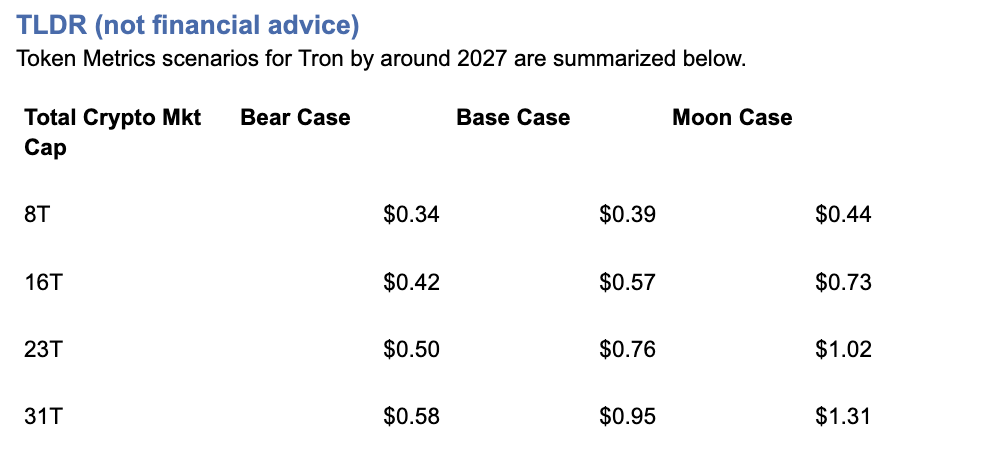
Current price: $0.2971.
How to read it: Each band blends cycle analogues and market-cap share math with TA guardrails. Base assumes steady adoption and neutral or positive macro. Moon layers in a liquidity boom. Bear assumes muted flows and tighter liquidity.
TM Agent baseline: Token Metrics TM Grade for $TRX is 19.06, which translates to a Strong Sell, and the trading signal is bearish, indicating short-term downward momentum. Price context: $TRX is trading around $0.297, market cap rank #10, and is down about 11% over 30 days while up about 80% year-over-year, it has returned roughly 963% since the last trading signal flip.
Live details: Tron Token Details → https://app.tokenmetrics.com/en/tron
Buy TRX: https://www.mexc.com/acquisition/custom-sign-up?shareCode=mexc-2djd4
• Scenario driven, outcomes hinge on total crypto market cap, higher liquidity and adoption lift the bands.
• TM Agent gist: bearish near term, upside depends on a sustained risk-on regime and improvements in TM Grade and the trading signal.
• Education only, not financial advice.
8T: 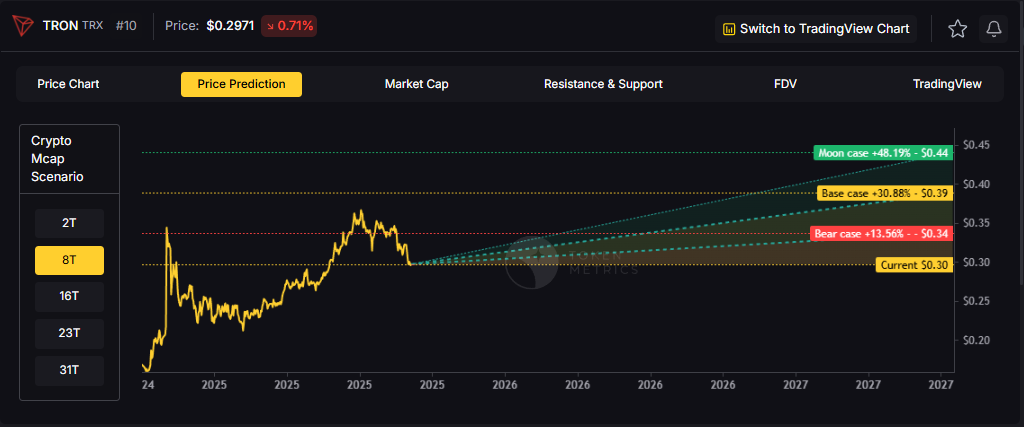
16T: 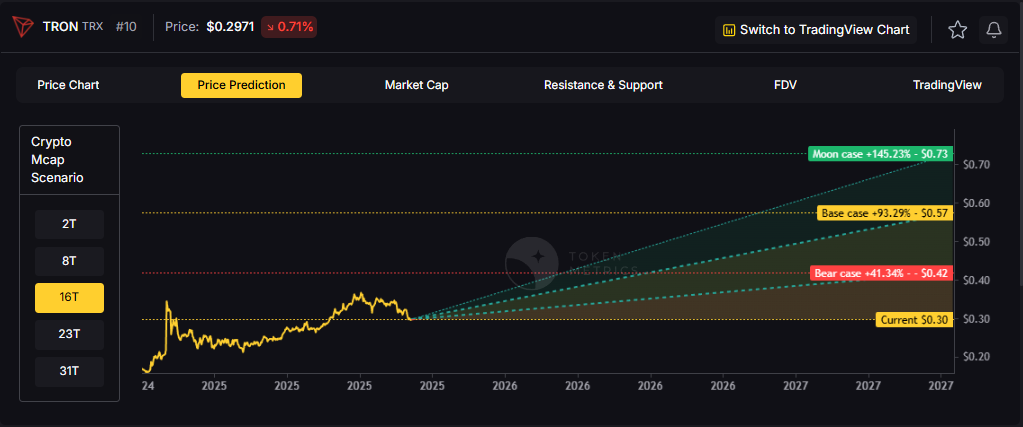
23T: 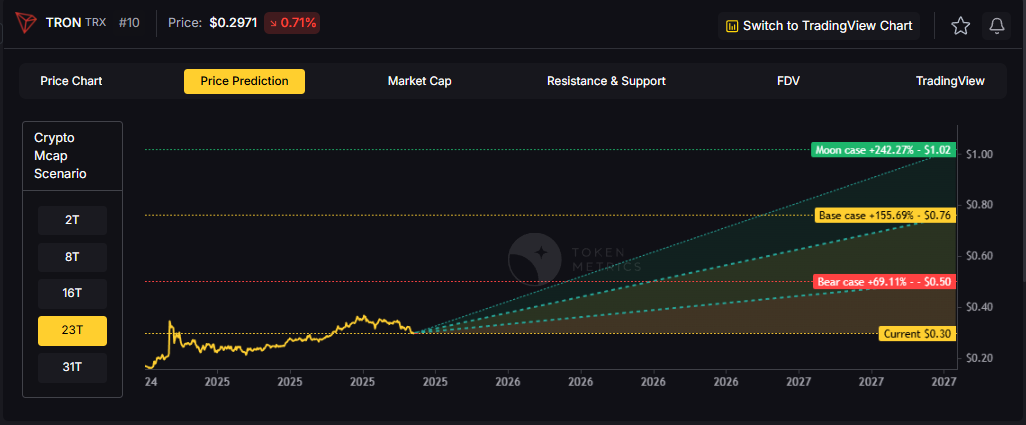
Diversification matters. Tron is compelling, yet concentrated bets can be volatile. Token Metrics Indices hold TRX alongside the top one hundred tokens for broad exposure to leaders and emerging winners.
Our backtests indicate that owning the full market with diversified indices has historically outperformed both the total market and Bitcoin in many regimes due to diversification and rotation.
Get early access: https://docs.google.com/forms/d/1AnJr8hn51ita6654sRGiiW1K6sE10F1JX-plqTUssXk/preview
If your editor supports embeds, place a form embed here. Otherwise, include the link above as a button labeled Join Indices Early Access.
Tron is a smart-contract blockchain focused on low-cost, high-throughput transactions and cross-border settlement.
The network supports token issuance and a broad set of dApps, with an emphasis on stablecoin transfer volume and payments.
TRX is the native asset that powers fees and staking for validators and delegators within the network.
Developers and enterprises use the chain for predictable costs and fast finality, which supports consumer-facing use cases.
Catalysts That Skew Bullish
• Institutional and retail access expands with ETFs, listings, and integrations.
• Macro tailwinds from lower real rates and improving liquidity.
• Product or roadmap milestones such as upgrades, scaling, or partnerships.
Risks That Skew Bearish
• Macro risk-off from tightening or liquidity shocks.
• Regulatory actions or infrastructure outages.
• Concentration or validator economics and competitive displacement.
Unlock platform-wide intelligence on every major crypto asset. Use code ADVANCED20 at checkout for twenty percent off.
• AI powered ratings on thousands of tokens for traders and investors.
• Interactive TM AI Agent to ask any crypto question.
• Indices explorer to surface promising tokens and diversified baskets.
• Signal dashboards, backtests, and historical performance views.
• Watchlists, alerts, and portfolio tools to track what matters.
• Early feature access and enhanced research coverage.
Start with Advanced today → https://www.tokenmetrics.com/token-metrics-pricing
Can TRX reach $1?
Yes, the 23T moon case shows $1.02 and the 31T moon case shows $1.31, which imply a path to $1 in higher-liquidity regimes. Not financial advice.
Is TRX a good long-term investment
Outcome depends on adoption, liquidity regime, competition, and supply dynamics. Diversify and size positions responsibly.
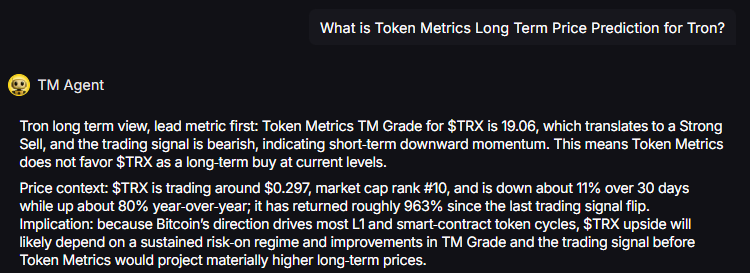
Track live grades and signals: Token Details → https://app.tokenmetrics.com/en/tron
Join Indices Early Access: https://docs.google.com/forms/d/1AnJr8hn51ita6654sRGiiW1K6sE10F1JX-plqTUssXk/preview
Want exposure Buy TRX on MEXC → https://www.mexc.com/acquisition/custom-sign-up?shareCode=mexc-2djd4
Disclosure
Educational purposes only, not financial advice. Crypto is volatile, do your own research and manage risk.
The cryptocurrency market presents unprecedented wealth-building opportunities, but it also poses significant challenges.
With thousands of tokens competing for investor attention and market volatility that can erase gains overnight, success in crypto investing requires more than luck—it demands a strategic, data-driven approach.
Token Metrics AI Indices have emerged as a game-changing solution for investors seeking to capitalize on crypto's growth potential while managing risk effectively.
This comprehensive guide explores how to leverage these powerful tools to build, manage, and optimize your cryptocurrency portfolio for maximum returns in 2025 and beyond.
The traditional approach to crypto investing involves countless hours of research, technical analysis, and constant market monitoring.
For most investors, this proves unsustainable.
Token Metrics solves this challenge by offering professionally managed, AI-driven index portfolios that automatically identify winning opportunities and rebalance based on real-time market conditions.
What makes Token Metrics indices unique is their foundation in machine learning technology.
The platform analyzes over 6,000 cryptocurrencies daily, processing more than 80 data points per asset including technical indicators, fundamental metrics, on-chain analytics, sentiment data, and exchange information.
This comprehensive evaluation far exceeds what individual investors can accomplish manually.
The indices employ sophisticated AI models including gradient boosting decision trees, recurrent neural networks, random forests, natural language processing algorithms, and anomaly detection frameworks.
These systems continuously learn from market patterns, adapt to changing conditions, and optimize portfolio allocations to maximize risk-adjusted returns.
Token Metrics offers a diverse range of indices designed to serve different investment objectives, risk tolerances, and market outlooks.
Understanding these options is crucial for building an effective crypto portfolio.
Conservative Indices: Stability and Long-Term Growth
For investors prioritizing capital preservation and steady appreciation, conservative indices focus on established, fundamentally sound cryptocurrencies with proven track records.
These indices typically allocate heavily to Bitcoin and Ethereum while including select large-cap altcoins with strong fundamentals.
The Investor Grade Index exemplifies this approach, emphasizing projects with solid development teams, active communities, real-world adoption, and sustainable tokenomics.
This index is ideal for retirement accounts, long-term wealth building, and risk-averse investors seeking exposure to crypto without excessive volatility.
Balanced Indices: Growth with Measured Risk
Balanced indices strike a middle ground between stability and growth potential.
These portfolios combine major cryptocurrencies with promising mid-cap projects that demonstrate strong technical momentum and fundamental strength.
The platform's AI identifies tokens showing positive divergence across multiple indicators—rising trading volume, improving developer activity, growing social sentiment, and strengthening technical patterns.
Balanced indices typically rebalance weekly or bi-weekly, capturing emerging trends while maintaining core positions in established assets.
Aggressive Growth Indices: Maximum Upside Potential
For investors comfortable with higher volatility in pursuit of substantial returns, aggressive growth indices target smaller-cap tokens with explosive potential.
These portfolios leverage Token Metrics' Trader Grade system to identify assets with strong short-term momentum and technical breakout patterns.
Aggressive indices may include DeFi protocols gaining traction, Layer-1 blockchains with innovative technology, AI tokens benefiting from market narratives, and memecoins showing viral adoption patterns.
While risk is higher, the potential for 10x, 50x, or even 100x returns makes these indices attractive for portfolio allocation strategies that embrace calculated risk.
Sector-Specific Indices: Thematic Investing
Token Metrics offers specialized indices targeting specific cryptocurrency sectors, allowing investors to align portfolios with their market convictions and thematic beliefs.
• DeFi Index: Focuses on decentralized finance protocols including lending platforms, decentralized exchanges, yield aggregators, and synthetic asset platforms.
• Layer-1 Index: Concentrates on base-layer blockchains competing with Ethereum, including Solana, Avalanche, Cardano, Polkadot, and emerging ecosystems.
• AI and Machine Learning Index: Targets tokens at the intersection of artificial intelligence and blockchain technology.
• Memecoin Index: Contrary to traditional wisdom dismissing memecoins as purely speculative, Token Metrics recognizes that community-driven tokens can generate extraordinary returns.
This index uses AI to identify memecoins with genuine viral potential, active communities, and sustainable momentum before they become mainstream.
Success with Token Metrics indices requires more than simply choosing an index—it demands a comprehensive portfolio strategy tailored to your financial situation, goals, and risk tolerance.
Step 1: Assess Your Financial Profile
Begin by honestly evaluating your investment capacity, time horizon, and risk tolerance.
Ask yourself critical questions: How much capital can I allocate to crypto without compromising financial security? What is my investment timeline—months, years, or decades? How would I react emotionally to a 30% portfolio drawdown? What returns do I need to achieve my financial goals?
Your answers shape your portfolio construction.
Conservative investors with shorter timelines should emphasize stable indices, while younger investors with longer horizons can embrace more aggressive strategies.
Step 2: Determine Optimal Allocation Percentages
Financial advisors increasingly recommend including cryptocurrency in diversified portfolios, but the appropriate allocation varies significantly based on individual circumstances.
• Conservative Allocation (5-10% of portfolio): Suitable for investors approaching retirement or with low risk tolerance. Focus 80% on conservative indices, 15% on balanced indices, and 5% on sector-specific themes you understand deeply.
• Moderate Allocation (10-20% of portfolio): Appropriate for mid-career professionals building wealth. Allocate 50% to conservative indices, 30% to balanced indices, and 20% to aggressive growth or sector-specific indices.
• Aggressive Allocation (20-30%+ of portfolio): Reserved for younger investors with high risk tolerance and long time horizons. Consider 30% conservative indices for stability, 30% balanced indices for steady growth, and 40% split between aggressive growth and thematic sector indices.
Step 3: Implement Dollar-Cost Averaging
Rather than investing your entire allocation at once, implement a dollar-cost averaging strategy over 3-6 months.
This approach reduces timing risk and smooths out entry prices across market cycles.
For example, if allocating $10,000 to Token Metrics indices, invest $2,000 monthly over five months.
This strategy proves particularly valuable in volatile crypto markets where timing the perfect entry proves nearly impossible.
Step 4: Set Up Automated Rebalancing
Token Metrics indices automatically rebalance based on AI analysis, but you should also establish personal portfolio rebalancing rules.
Review your overall allocation quarterly and rebalance if any index deviates more than 10% from your target allocation.
If aggressive growth indices perform exceptionally well and grow from 20% to 35% of your crypto portfolio, take profits and rebalance back to your target allocation.
This disciplined approach ensures you systematically lock in gains and maintain appropriate risk levels.
Step 5: Monitor Performance and Adjust Strategy
While Token Metrics indices handle day-to-day portfolio management, you should conduct quarterly reviews assessing overall performance, comparing returns to benchmarks like Bitcoin and Ethereum, evaluating whether your risk tolerance has changed, and considering whether emerging market trends warrant allocation adjustments.
Use Token Metrics' comprehensive analytics to track performance metrics including total return, volatility, Sharpe ratio, maximum drawdown, and correlation to major cryptocurrencies.
These insights inform strategic decisions about continuing, increasing, or decreasing exposure to specific indices.
Once comfortable with basic index investing, consider implementing advanced strategies to enhance returns and manage risk more effectively.
Tactical Overweighting
While maintaining core index allocations, temporarily overweight specific sectors experiencing favorable market conditions.
During periods of heightened interest in AI, increase allocation to the AI and Machine Learning Index by 5-10% at the expense of other sector indices.
Return to strategic allocation once the catalyst dissipates.
Combining Indices with Individual Tokens
Use Token Metrics indices for 70-80% of your crypto allocation while dedicating 20-30% to individual tokens identified through the platform's Moonshots feature.
This hybrid approach provides professional management while allowing you to pursue high-conviction opportunities.
Market Cycle Positioning
Adjust index allocations based on broader market cycles.
During bull markets, increase exposure to aggressive growth indices.
As conditions turn bearish, shift toward conservative indices with strong fundamentals.
Token Metrics' AI Indicator provides valuable signals for market positioning.
Even with sophisticated AI-driven indices, cryptocurrency investing carries substantial risks.
Implement robust risk management practices to protect your wealth.
Diversification Beyond Crypto
Never allocate so much to cryptocurrency that a market crash would devastate your financial position.
Most financial advisors recommend limiting crypto exposure to 5-30% of investment portfolios depending on age and risk tolerance.
Maintain substantial allocations to traditional assets—stocks, bonds, real estate—that provide diversification and stability.
Position Sizing and Security
Consider implementing portfolio-level stop-losses if your crypto allocation declines significantly from its peak.
Use hardware wallets or secure custody solutions for significant holdings.
Implement strong security practices including two-factor authentication and unique passwords.
Tax Optimization
Cryptocurrency taxation typically involves capital gains taxes on profits.
Consult tax professionals to optimize your strategy through tax-loss harvesting and strategic rebalancing timing.
Token Metrics' transaction tracking helps maintain accurate records for tax reporting.
Several factors distinguish Token Metrics indices from alternatives and explain their consistent outperformance.
Token Metrics indices respond to market changes in real-time rather than waiting for scheduled monthly or quarterly rebalancing.
This responsiveness proves crucial in crypto markets where opportunities can appear and disappear rapidly.
The platform's AI evaluates dozens of factors simultaneously—technical patterns, fundamental strength, on-chain metrics, sentiment analysis, and exchange dynamics.
This comprehensive approach identifies tokens that traditional indices would miss.
The AI continuously learns from outcomes, improving predictive accuracy over time.
Models that underperform receive reduced weighting while successful approaches gain influence, creating an evolving system that adapts to changing market dynamics.
Token Metrics' extensive coverage of 6,000+ tokens provides exposure to emerging projects before they gain mainstream attention, positioning investors for maximum appreciation potential.
To illustrate practical application, consider several investor profiles and optimal index strategies.
Profile 1: Conservative 55-Year-Old Preparing for Retirement
Total portfolio: $500,000
Crypto allocation: $25,000 (5%)
Strategy: $20,000 in Investor Grade Index (80%), $4,000 in Balanced Index (16%), $1,000 in DeFi Index (4%)
This conservative approach provides crypto exposure with minimal volatility, focusing on established assets likely to appreciate steadily without risking retirement security.
Profile 2: Moderate 35-Year-Old Building Wealth
Total portfolio: $150,000
Crypto allocation: $30,000 (20%)
Strategy: $12,000 in Investor Grade Index (40%), $9,000 in Balanced Index (30%), $6,000 in Layer-1 Index (20%), $3,000 in Aggressive Growth Index (10%)
This balanced approach captures crypto growth potential while maintaining stability through substantial conservative and balanced allocations.
Profile 3: Aggressive 25-Year-Old Maximizing Returns
Total portfolio: $50,000
Crypto allocation: $15,000 (30%)
Strategy: $4,500 in Investor Grade Index (30%), $3,000 in Balanced Index (20%), $4,500 in Aggressive Growth Index (30%), $3,000 in Memecoin Index (20%)
This aggressive strategy embraces volatility and maximum growth potential, appropriate for younger investors with decades to recover from potential downturns.
Ready to begin building wealth with Token Metrics indices?
Follow this action plan:
• Week 1-2: Sign up for Token Metrics' 7-day free trial and explore available indices, historical performance, and educational resources. Define your investment goals, risk tolerance, and allocation strategy using the frameworks outlined in this guide.
• Week 3-4: Open necessary exchange accounts and wallets. Fund accounts and begin implementing your strategy through dollar-cost averaging. Set up tracking systems and calendar reminders for quarterly reviews.
• Ongoing: Follow Token Metrics' index recommendations, execute rebalancing transactions as suggested, monitor performance quarterly, and adjust strategy as your financial situation evolves.
Cryptocurrency represents one of the most significant wealth-building opportunities in modern financial history, but capturing this potential requires sophisticated approaches that most individual investors cannot implement alone.
Token Metrics AI Indices democratize access to professional-grade investment strategies, leveraging cutting-edge machine learning, comprehensive market analysis, and real-time responsiveness to build winning portfolios.
Whether you're a conservative investor seeking measured exposure or an aggressive trader pursuing maximum returns, Token Metrics provides indices tailored to your specific needs.
The choice between random coin picking and strategic, AI-driven index investing is clear.
One approach relies on luck and guesswork; the other harnesses data, technology, and proven methodologies to systematically build wealth while managing risk.
Your journey to crypto investment success begins with a single decision: commit to a professional, strategic approach rather than speculative gambling.
Token Metrics provides the tools, insights, and management to transform crypto investing from a game of chance into a calculated path toward financial freedom.
Start your 7-day free trial today and discover how AI-powered indices can accelerate your wealth-building journey.
The future of finance is decentralized, intelligent, and accessible—make sure you're positioned to benefit.
Token Metrics stands out as a leader in AI-driven crypto index solutions.
With over 6,000 tokens analyzed daily and indices tailored to every risk profile, the platform provides unparalleled analytics, real-time rebalancing, and comprehensive investor education.
Its commitment to innovation and transparency makes it a trusted partner for building your crypto investment strategy in today's fast-evolving landscape.
Token Metrics indices use advanced AI models to analyze technical, fundamental, on-chain, and sentiment data across thousands of cryptocurrencies.
They construct balanced portfolios that are automatically rebalanced in real-time to adapt to evolving market conditions and trends.
There are conservative, balanced, aggressive growth, and sector-specific indices including DeFi, Layer-1, AI, and memecoins.
Each index is designed for a different investment objective, risk tolerance, and market outlook.
No mandatory minimum is outlined for using Token Metrics indices recommendations.
You can adapt your allocation based on your personal investment strategy, capacity, and goals.
Token Metrics indices are rebalanced automatically based on dynamic AI analysis, but it is recommended to review your overall crypto allocation at least quarterly to ensure alignment with your targets.
Token Metrics provides analytics and index recommendations; investors maintain custody of their funds and should implement robust security practices such as hardware wallets and two-factor authentication.
No investing approach, including AI-driven indices, can guarantee profits.
The goal is to maximize risk-adjusted returns through advanced analytics and professional portfolio management, but losses remain possible due to the volatile nature of crypto markets.
This article is for educational and informational purposes only.
It does not constitute financial, investment, or tax advice.
Cryptocurrency investing carries risk, and past performance does not guarantee future results. Always consult your own advisor before making investment decisions.
